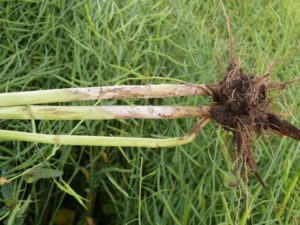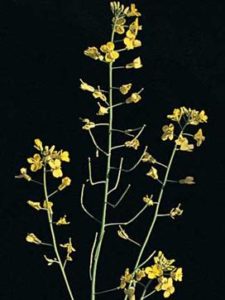
OCGA’s yield challenge has continued to push the canola yield boundry, with yields of 3,000– 4,000 lb/ac being achieved by REAL canola growers! Added attention to management will be rewarded with more consistent top yields. Sclerotinia is one of the biggest threats to your canola yield. An early outbreak can cut your yield by 25% or more. Sclerotinia incidence varies greatly between fields and years thus making routine spraying of fungicide unprofitable. However, if your canola has good yield potential and if conditions are moist at flowering, spraying a fungicide will likely provide a payback. Be informed, be prepared!
Higher risk in 2015?
Moist soil conditions promote growth of overwintering sclerotia from previously infected soybean and canola plants. Last years high rates of infection of soybeans and canola will ensure wide spread of sclerotinia spores through the countryside this season.
Will it pay to spray?
If your field has good soil moisture ahead of flowering that promotes germination of soil sclerotia and spore production, along with rain/high humidity during flowering, then infection is likely. You cant wait to see the disease before spraying; rather you must look at environmental conditions to forecast a problem.

Risk Factor Checklist
? Fields with history of sclerotinia in soybeans, canola or dry beans.
? Dense crop canopy.
? Rainfall prior to flowering– 25 to 50 mm ( 1 to 2”) of rain that saturates the soil in the two weeks prior to bloom is needed for spore production.
? Rainfall and high humidty during flowering that keeps the canopy wet for 2-3 days and results in a lot of petal ‘stick’ are ideal for infection. Optimum temperature for sclerotinia growth is 15 to 200. Temperatures over 300 C (860 F) stop disease development. High humidity during flowering is big driver in how quickly infection develops. For instance research with lettuce which is also susceptible to sclerotina showed that at 50% humidity it took 17-18 days for 10% of plants to show infection but at 80% humidity, the same level of infection appeared in 8-9 days.
Should you spray early, late or both?
Fungicides are only effective as protectant and must be applied prior to infection. They have no curative action.
Flower petals that drop into the canopy are the initial point of infection for sclerotinia (i.e. food source). Early infections that attack the main stem cause the most serious yield loss. By spraying at 20-30% bloom, the greatest number of open flowers will be covered before petal drop occurs. This will result in the best coverage and protection. First petal drop is around 30% flower. It only takes few days to go from 20 to 30 to 50%. If significant petal drop has occurred then canola is likely at or past 50% If a field is varied and uneven in flowering but warrants spraying, time application for when the greatest percentage of canola plants are at the correct stage.

What about a later application at 50% flower?
Although the fungicide timing window closes at 50% flower, some years later application (up to 50% bloom) can be the most effective if conditions are dry early, but rainfall is received later. If you missed the early application window, infection has not occurred and conditions are right for infection, a late application can still be profitable. Split applications can be worthwhile if conditions are good for late infection, flowering is extended, or canola crop with multiple stage plants. In this case time first application at 20% flower, and follow-up with 2n application at 50%. Most products provide protection for 7-14 days. Apply full label rate with each application for maximum protection. Cutting rates, reduces protection. Note that not all products are registered for two applications.

Which products are Registered?1 If more than one fungicide application is required per season, then fungicides with different modes of action should be used.
| % Flowering Stage | Number of Open Flowers on Main Stem | Time from First Flower Days (approximate) |
| 10 | At least 10 | 2 – 4 days |
| 20 | 14 – 16 (no petal drop) | 5 – 6 days |
| 30 | At least 20 | 7 – 8 days |
| For images of bloom stage, refer to the Bayer bloom guide posted on the Ontario Canola Growers website at www.ontariocanolagrowers.ca | ||
| Product (Company) | Application Window | Split Application | Pre-harvest Interval (PHI)- days | Fungicide Group1 |
| Lance (BASF) | 20—50% flower | Yes, 7-10 days apart | 21 | 7 |
| Proline (BAYER) | 20—50% flower | No | 36 | 3 |
| Astound (Syngenta) | 20—50% flower | No | 35 | 9 & 12 |
| Quadris (Syngenta) | Prior to 30% flower | No | 30 | 11 |
| Serenade ASO (suppression only) (BAYER) | 20—50% flower | Yes 7-10 days apart | None | 44 |
| Quash | 20—50% flower | No | 45 | 3 |
| Vertisan (DuPont) | 20—50% flower | Yes, 7-14 days apart | 21 | 7 |